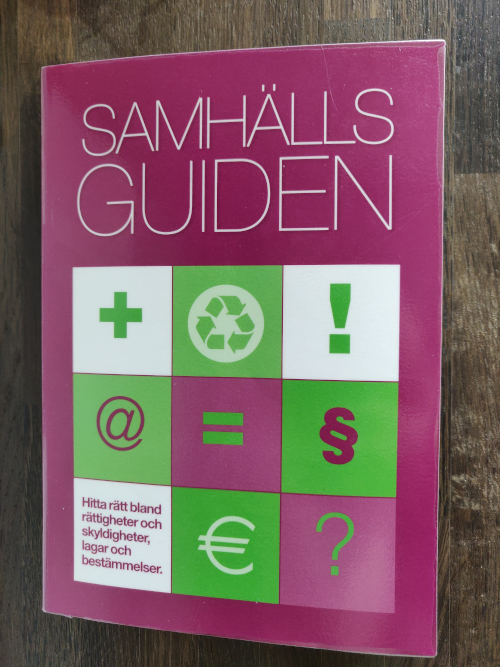Samhällsguiden: en handbok i offentlig service edited by Marianne Ahlgren

This book is not exactly light reading. It’s more than 600 pages of laws, rights, and rules. Thirty-one chapters on education, healthcare, culture, taxes, work, pension, elections, and so on — I don’t think there’s anything it does not cover. Due to the number of topics though it does not go deep; it’s more about informing the reader that something exists and pointing in the right direction. There are no pro-tips, gotchas or layman explanations.
Most of the book is legalese — not hardcore, kidnap-a-lawyer-if-you-want-to-grok-it sort of legalese, but still legalese. Which is a pity, since people who would benefit the most from this “guide to Swedish society” are also the ones it would be the least approachable for.
Random bits and pieces I learned from Samhällsguiden:
-
sambor (cohabiting partners) and married people are the same before law, except when they want to adopt (only married couples can) or inherit from each other (that includes a rental contract)
-
at least once per school semester every pupil has a talk with their teacher and parents about the best way their knowledge and social development can be supported; it’s called utvecklingssamtal — same as the yearly performance review talk people get at work
-
if a parent needs to learn the sign language to communicate with their child and misses work because of this, they can get money from CSN, the Swedish Board of Student Finance
-
Arbetsförmedlingen, the unemployment office, has webinars (e.g. about writing a CV) and a podcast
-
if a company employs 10 people or less and needs to do a lay-off, it gets to choose maximum two of them to be exempted from the “last in — first out” rule
-
if a rental contract specifies a longer notice period than three full months, the tenant is not bound by this condition, but the landlord is
-
it’s not necessary to have a digital postbox (like Kivra) to get the tax return already in April
-
if someone was caught driving drunk, they can apply to get a special condition on their driving license instead of having it taken away. The condition is that they only get to drive cars equipped with alcolock manufactured by a company approved by Transportstyrelsen. This condition’s code is 69, and a driving license with this condition is only valid within Sweden
-
if a letter can’t be delivered and doesn’t have the sender’s address on it, a special office in Kiruna will open the letter and try to investigate who the sender is to return the letter
-
61% of Swedes are members of the Swedish church
-
a Swede can’t get more than three passports within the same five-year period
-
a Swedish flag shall not be used if it’s dirty or worn out. If it’s worn out, it’s forbidden to use it in a non-flag way: it should be burned or disposed of in another dignified fashion
-
citizens of the EU, Norway, and Iceland get to vote in the local elections of Sweden if they reside there; citizens of other countries get to vote in the local elections after three years of residence
-
there’s a website which aims to explain things about being subjected to crime to kids of different ages; there are also brochures in languages other than Swedish (e.g. “What happens at a trial” in English)
-
home insurance usually has legal costs insurance included.
I got my hands on the 31st edition of the book. It was printed in 2019. Some rules have already changed since then, so I think it would make no sense to read an older version. I also can’t recommend reading this formidable brick of a book from cover to cover — there are few people on this planet to whom all of it would apply — but walking up to it in a library and checking out the links and references in a particular chapter might work well.
★★★☆☆
(715 pages, ISBN: 9789138327449, Worldcat, Open Library)
There is no comments section, but if you'd like to give feedback or ask questions about this post, please contact me.